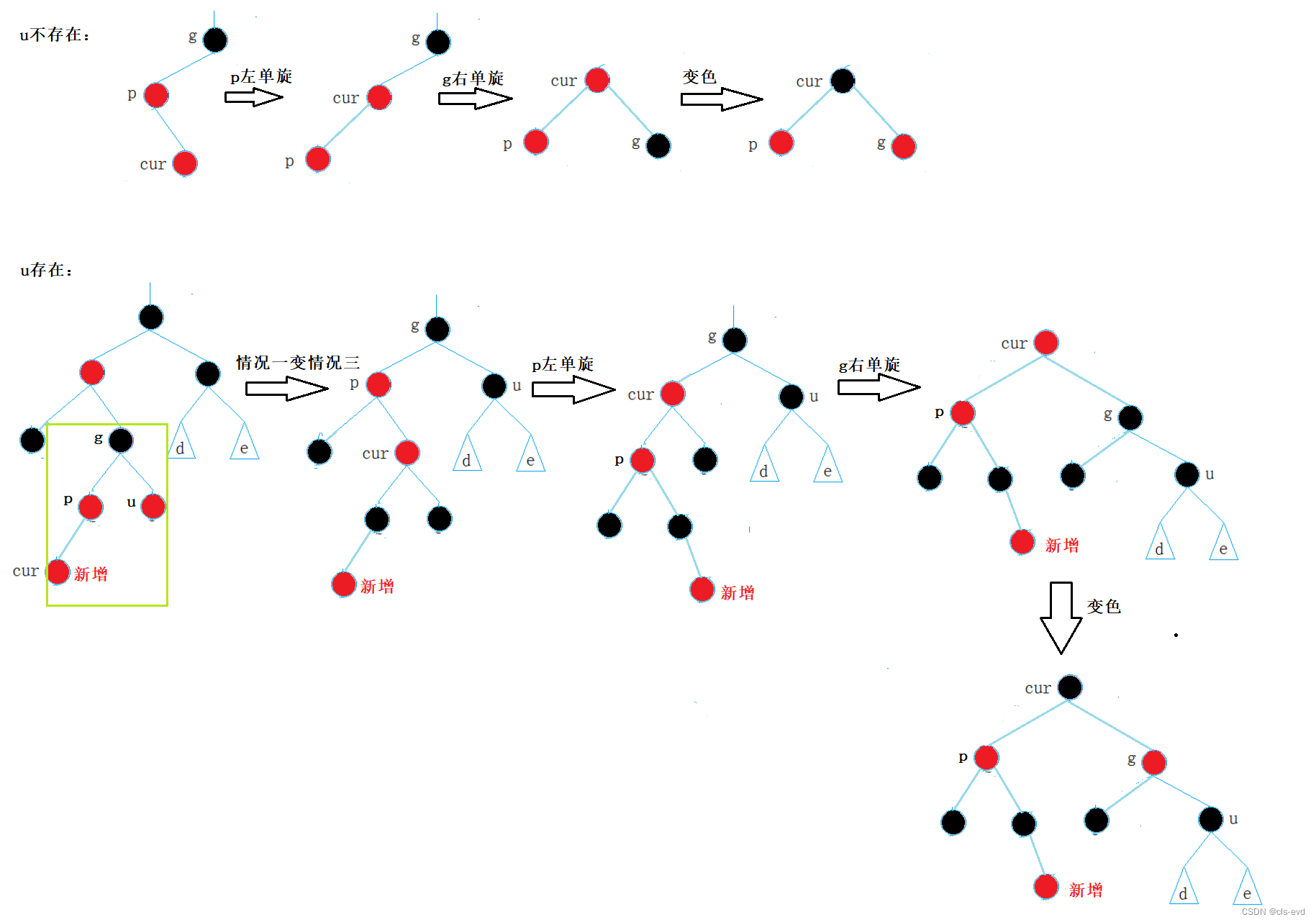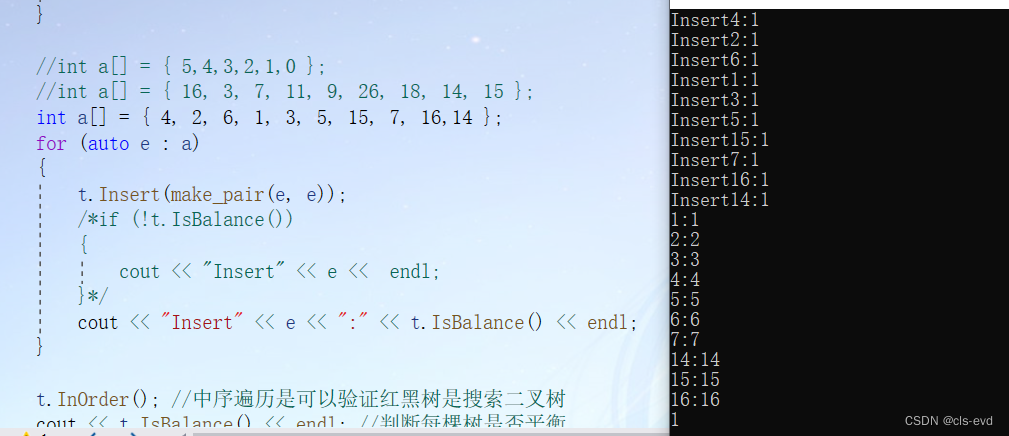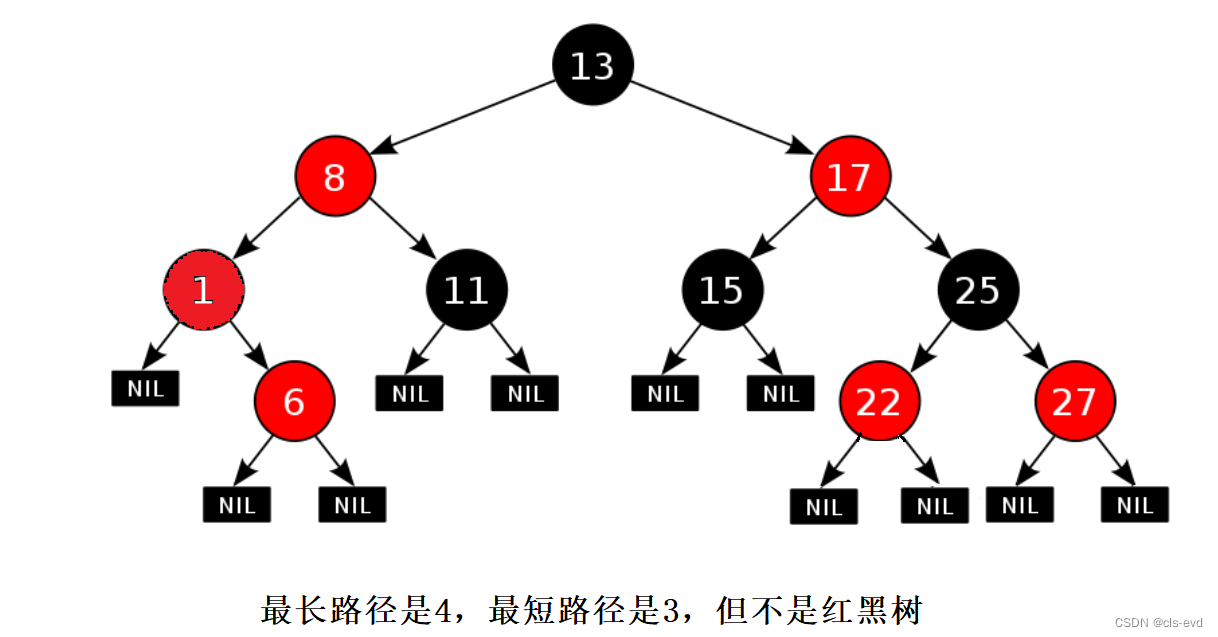前言:博主的重点是实现红黑树的插入
目录
思考:为什么满足上面的性质,红黑树就能保证:其最长路径中节点个数不会超过最短路径节点个数的两倍?
?编辑情况三: cur为红,p为红,g为黑,u不存在/u为黑
红黑树
红黑树的概念
红黑树 ,是一种 二叉搜索树 ,但 在每个结点上增加一个存储位表示结点的颜色,可以是 Red 或 Black 。 通过对任何一条从根到叶子的路径上各个结点着色方式的限制,红黑树确保没有一条路径会比其他路径长出俩 倍 ,因而是 接近平衡 的。

红黑树的性质
1. 每个结点不是红色就是黑色2. 根节点是黑色的?3. 如果一个节点是红色的,则它的两个孩子结点是黑色的?,但是没有连续的红节点4. 对于每个结点,从该结点到其所有后代叶结点的简单路径上,均包含相同数目的黑色结点(每条路径的黑色节点都相同)?5. 每个叶子结点都是黑色的 ( 此处的叶子结点指的是空结点,也就是NIL节点 )eg:该树只有两个节点
因此性质5平常我们是不用去关注它的,但我们要知道它对应的是哪种情况即可。
思考:为什么满足上面的性质,红黑树就能保证:其最长路径中节点个数不会超过最短路径节点个数的两倍?
最短路径:全是黑节点最长路径:一黑一红一黑一红....假设每条路径黑节点是N,那么N<=任意路径<=2N。
AVL树与红黑树效率的比较
AVL树左右两边更均衡,高度更接近logN。红黑树左右两边并没有那么均衡,它的整体高度:假设红黑树中一条路径的黑色节点的数量是X假设红黑树的高度是h,? ? ? ? 2X>=h>=X.N是树中节点的数量2^X-1<=? ? ? ? ? ?N? ? ? ? ? <=2^X=2X-1全黑满二叉树? ? ? ? ? ? ? ? ? 一黑一红满二叉树X<=㏒?N+1? ? ? ? ? ? ? ? ? ? ?X>=(log?N+1)/2黑色最坏情况是㏒?N,加上红色以后最坏情况就是2*㏒?N结论:AVL 树严格平衡,效率logN,红黑树接近平衡,效率是2*logN;
为什么红黑树用的跟多呢?
因为在内存中CPU非常快,N对于CPU非常小,假如N是10亿,AVL找30次,红黑树找60次。这对于CPU是没差别的。就好比你有1块与你有5毛的区别,不管你有哪个你都是穷的;另外AVL树达到平衡需要很多次的旋转才能达到,但是红黑树却不需要旋转,也就是说AVL树结果虽然比红黑树好一点,但是这一丁点是无足轻重的,而且为了好这一点AVL树付出了很大旋转的代价; 所以红黑树在经常进行增删的结构 中性能比 AVL 树更优,而且红黑树实现比较简单,所以实际运用中红黑树更多。
红黑树的实现
红黑树节点的定义
enum Colour
{
RED,
BLACK
};
template<class K,class V>
struct RBTreeNode
{
RBTreeNode<K, V>* _left;
RBTreeNode<K, V>* _right;
RBTreeNode<K, V>* _parent;
pair<K, V> _kv;
Colour _col;
RBTreeNode(const pair<K, V>& kv)
:_left(nullptr)
, _right(nullptr)
, _parent(nullptr)
, _col(RED) //红的黑的都无所谓
, _kv(kv)
{}
};在节点的定义中,为什么要将节点的默认颜色给成红色的?
插入黑节点或者插入红节点就代表着破坏规则3和4,但是破坏规则3的代价要比破坏4的代价小很多?。所以我们默认插入的是红节点。
红黑树的插入操作
红黑树是在二叉搜索树的基础上加上其平衡限制条件,因此红黑树的插入可分为两步:
1. 按照二叉搜索的树规则插入新节点
bool Insert(const pair<K, V>& kv)
{
if (_root == nullptr)
{
_root = new Node(kv);
_root->_col = BLACK; //将根节点处理成黑色
return true;
}
Node* parent = nullptr;
Node* cur = _root;
while (cur)
{
if (cur->_kv.first < kv.first)
{
parent = cur;
cur = cur->_right;
}
else if (cur->_kv.first > kv.first)
{
parent = cur;
cur = cur->_left;
}
else
{
return false;
}
}
cur = new Node(kv);
cur->_col = RED; //新增节点处理成红色
if (parent->_kv.first < kv.first)
{
parent->_right = cur;
cur->_parent = parent; //把三叉链链上
}
else
{
parent->_left = cur;
cur->_parent = parent;
}
//控制平衡
return true;
}2. 检测新节点插入后,红黑树的性质是否造到破坏
因为 新节点的默认颜色是红色 ,因此:如果 其双亲节点的颜色是黑色,没有违反红黑树任何性质 ,则不需要调整;但当新插入节点的双亲节点颜色为红色时,就违反了性质三不能有连在一起的红色节点 ,此时需要对红黑树分情况来讨论:
约定:cur为当前节点,p为父节点,g为祖父节点,u为叔叔节点
情况一: cur为红,p为红,g为黑,u存在且为红
解决方式:
将p,u改为黑,g改为红,然后把g当成cur,继续向上调整。
抽象图:

具象图:

情况二: cur为红,p为红,g为黑,u不存在/u为黑
解决方法:
p 为 g 的左孩子, cur 为 p 的左孩子,则进行右单旋转;相反,p 为 g 的右孩子, cur 为 p 的右孩子,则进行左单旋转p 、 g 变色 --p 变黑, g 变红
抽象图:?
 具象图:
具象图:
 情况三: cur为红,p为红,g为黑,u不存在/u为黑
情况三: cur为红,p为红,g为黑,u不存在/u为黑
解决方法:
p
为
g
的左孩子,
cur
为
p
的右孩子,则针对
p
做左单旋转,对g进行右单旋转
;
p
为
g
的右孩子,
cur
为
p
的左孩子,则针对
p
做右单旋转,对g进行左单旋转;
cur、
g
变色
--cur
变黑,
g
变红
抽象图:??
 具象图:
具象图:

完整代码:
//控制平衡
while (parent&& parent->_col == RED) //父亲存在且为红一定不是根
{
Node* grangfather = parent->_parent;
if (parent == grangfather->_left) //父亲在g的左
{
Node* uncle = grangfather->_right;
if (uncle && uncle->_col == RED)//情况一:叔叔存在且为红
{
//变色+继续向上处理
parent->_col = uncle->_col = BLACK;
grangfather->_col = RED;
cur = grangfather;
parent = cur->_parent;
}
else //情况二+三:叔叔存在/叔叔存在且为黑
{
// g
// p
//c
// g
// p
// c
if (cur == parent->_left) //情况二
{
//单旋
RotateR(grangfather);
parent->_col = BLACK;
grangfather->_col = RED;
}
else //情况三
{
//双旋
RotateL(parent);
RotateR(grangfather);
cur->_col = BLACK;
grangfather->_col = RED;
}
break; //我这棵树旋转完成了后,每条路径黑节点的个数没变,不会影响其他路径,这棵字树的根已经是黑色了,与情况一不同
}
}
else//parent == grangfather->_right p在g的右
{
Node* uncle = grangfather->_left;
if (uncle && uncle->_col == RED)//情况一:叔叔存在且为红
{
//变色+继续向上处理
parent->_col = uncle->_col = BLACK;
grangfather->_col = RED;
cur = grangfather;
parent = cur->_parent;
}
else //情况二+三:叔叔存在/叔叔存在且为黑
{
// g
// p
// c
// g
// p
// c
if (cur == parent->_right) //情况二
{
RotateL(grangfather);
parent->_col = BLACK;
grangfather->_col = RED;
}
else //情况三
{
RotateR(parent);
RotateL(grangfather);
cur->_col = BLACK;
grangfather->_col = RED;
}
break; //我这棵树旋转完成了后,每条路径黑节点的个数没变,不会影响其他路径,这棵字树的根已经是黑色了,与情况一不同
}
}
}
_root->_col = BLACK;红黑树的验证 ?
红黑树的检测分为两步:
1. 检测其是否满足二叉搜索树(中序遍历是否为有序序列)
中序遍历代码:
void InOrder()
{
_InOrder(_root);
}
void _InOrder(Node* root)
{
if (root == nullptr)
{
return;
}
_InOrder(root->_left);
cout << root->_kv.first << ":" << root->_kv.second << endl;
_InOrder(root->_right);
}2. 检测其是否满足红黑树的性质
可以用最长路径不超过最短路径的二倍检查吗?
可以但是不好,eg:
- 每个节点不是红色就是黑色,好检查,我们的颜色本身就是枚举值。
- 根节点是黑色,好检查。
- 每个节点是红色,则它的孩子都是黑的,我们可以通过遍历去检查红节点,然后再检查它的孩子是不是黑节点,但是这样不好,因为红节点的孩子的情况很多,可能存在2个,1个或者0个;所以我们可以通过检查红节点的父亲结点是不是黑节点来进行检查。
- 如何检查每条路径的黑色节点的个数都相等?通过将一条最左路径的黑色节点数量做基准值,然后递归每条路径,与这个基准值做比较,如果相等则代表没问题,不相等就代表出现问题
检查代码:
bool IsBalance()
{
if (_root && _root->_col == RED)
{
cout << "根节点不是黑色" << endl;
return false;
}
//最左路径的黑色节点数量做基准值
int banchmark = 0;
Node* left = _root;
while (left)
{
if (left->_col == BLACK)
++banchmark;
left = left->_left;
}
int blackNum = 0;
return _IsBalance(_root, banchmark, blackNum);
}
bool _IsBalance(Node* root, int banchmark, int blackNum)
{
//依据规则进行检查
if (root == nullptr)
{
if (blackNum != banchmark)
{
cout << "存在路径黑色节点的数量不相等" << endl;
return false;
}
return true;
}
if (root->_col == RED && root->_parent->_col == RED)
{
cout << "出现连续的红色节点" << endl;
return false;
}
if (root->_col == BLACK)
{
++blackNum;
}
return _IsBalance(root->_left, banchmark, blackNum)
&& _IsBalance(root->_right, banchmark, blackNum);
}红黑树的测试
void TestRBtree()
{
RBTree<int, int> t;
//int a[] = { 5,4,3,2,1,0 };
//int a[] = { 16, 3, 7, 11, 9, 26, 18, 14, 15 };
int a[] = { 4, 2, 6, 1, 3, 5, 15, 7, 16,14 };
for (auto e : a)
{
t.Insert(make_pair(e, e));
/*if (!t.IsBalance())
{
cout << "Insert" << e << endl;
}*/
cout << "Insert" << e << ":" << t.IsBalance() << endl;
}
t.InOrder(); //中序遍历是可以验证红黑树是搜索二叉树
cout << t.IsBalance() << endl; //判断每棵树是否平衡
//可以用最长路径不超过最短路径的二倍检查吗?可以但是不好
//cout << "深度" << t.Height() << endl;
} 红黑树的删除
红黑树的删除
红黑树的删除不做讲解,如果有兴趣可参考:《算法导论》或者《 STL 源码剖析》,或者下面两位大佬的博客。http://www.cnblogs.com/fornever/archive/2011/12/02/2270692.htmlhttp://blog.csdn.net/chenhuajie123/article/details/11951777
红黑树的应用
1.
C++ STL
库
-- map/set
、
mutil_map/mutil_set
2. Java
库
3. linux
内核
4.
其他一些库
红黑树的完整代码
#pragma once
#include<iostream>
#include<vector>
using namespace std;
enum Colour
{
RED,
BLACK
};
template<class K,class V>
struct RBTreeNode
{
RBTreeNode<K, V>* _left;
RBTreeNode<K, V>* _right;
RBTreeNode<K, V>* _parent;
pair<K, V> _kv;
Colour _col;
RBTreeNode(const pair<K, V>& kv)
:_left(nullptr)
, _right(nullptr)
, _parent(nullptr)
, _col(RED) //红的黑的都无所谓
, _kv(kv)
{}
};
template<class K, class V>
struct RBTree
{
typedef RBTreeNode<K, V> Node;
public:
RBTree()
:_root(nullptr)
{}
bool Insert(const pair<K, V>& kv)
{
if (_root == nullptr)
{
_root = new Node(kv);
_root->_col = BLACK; //将根节点处理成黑色
return true;
}
Node* parent = nullptr;
Node* cur = _root;
while (cur)
{
if (cur->_kv.first < kv.first)
{
parent = cur;
cur = cur->_right;
}
else if (cur->_kv.first > kv.first)
{
parent = cur;
cur = cur->_left;
}
else
{
return false;
}
}
cur = new Node(kv);
cur->_col = RED; //新增节点处理成红色
if (parent->_kv.first < kv.first)
{
parent->_right = cur;
cur->_parent = parent; //把三叉链链上
}
else
{
parent->_left = cur;
cur->_parent = parent;
}
//控制平衡
while (parent&& parent->_col == RED) //父亲存在且为红一定不是根
{
Node* grangfather = parent->_parent;
if (parent == grangfather->_left) //父亲在g的左
{
Node* uncle = grangfather->_right;
if (uncle && uncle->_col == RED)//情况一:叔叔存在且为红
{
//变色+继续向上处理
parent->_col = uncle->_col = BLACK;
grangfather->_col = RED;
cur = grangfather;
parent = cur->_parent;
}
else //情况二+三:叔叔存在/叔叔存在且为黑
{
// g
// p
//c
// g
// p
// c
if (cur == parent->_left) //情况二
{
//单旋
RotateR(grangfather);
parent->_col = BLACK;
grangfather->_col = RED;
}
else //情况三
{
//双旋
RotateL(parent);
RotateR(grangfather);
cur->_col = BLACK;
grangfather->_col = RED;
}
break; //我这棵树旋转完成了后,每条路径黑节点的个数没变,不会影响其他路径,这棵字树的根已经是黑色了,与情况一不同
}
}
else//parent == grangfather->_right p在g的右
{
Node* uncle = grangfather->_left;
if (uncle && uncle->_col == RED)//情况一:叔叔存在且为红
{
//变色+继续向上处理
parent->_col = uncle->_col = BLACK;
grangfather->_col = RED;
cur = grangfather;
parent = cur->_parent;
}
else //情况二+三:叔叔存在/叔叔存在且为黑
{
// g
// p
// c
// g
// p
// c
if (cur == parent->_right) //情况二
{
RotateL(grangfather);
parent->_col = BLACK;
grangfather->_col = RED;
}
else //情况三
{
RotateR(parent);
RotateL(grangfather);
cur->_col = BLACK;
grangfather->_col = RED;
}
break; //我这棵树旋转完成了后,每条路径黑节点的个数没变,不会影响其他路径,这棵字树的根已经是黑色了,与情况一不同
}
}
}
_root->_col = BLACK;
return true;
}
void RotateR(Node* parent)
{
Node* subL = parent->_left;
Node* subLR = subL->_right;
parent->_left = subLR;
if (subLR) //不为空才链接,否则就出现空指针问题
{
subLR->_parent = parent;
}
Node* parentParent = parent->_parent; //提前记录一下parent的父亲
subL->_right = parent;
parent->_parent = subL;
if (parent == _root) //如果是一颗独立的树
{
_root = subL;
_root->_parent = nullptr;
}
else
{
if (parentParent->_left == parent) //改变parent父亲的链接
{
parentParent->_left = subL;
}
else
{
parentParent->_right = subL;
}
subL->_parent = parentParent; //注意三叉链接
}
}
void RotateL(Node* parent)
{
Node* subR = parent->_right;
Node* subRL = subR->_left;
parent->_right = subRL;
if (subRL)
{
subRL->_parent = parent;
}
Node* parentParent = parent->_parent;
subR->_left = parent;
parent->_parent = subR;
if (parent == _root)
{
_root = subR;
_root->_parent = nullptr;
}
else
{
if (parentParent->_left == parent)
{
parentParent->_left = subR;
}
else
{
parentParent->_right = subR;
}
subR->_parent = parentParent;
}
}
void InOrder()
{
_InOrder(_root);
}
void _InOrder(Node* root)
{
if (root == nullptr)
{
return;
}
_InOrder(root->_left);
cout << root->_kv.first << ":" << root->_kv.second << endl;
_InOrder(root->_right);
}
bool IsBalance()
{
if (_root && _root->_col == RED)
{
cout << "根节点不是黑色" << endl;
return false;
}
//最左路径的黑色节点数量做基准值
int banchmark = 0;
Node* left = _root;
while (left)
{
if (left->_col == BLACK)
++banchmark;
left = left->_left;
}
int blackNum = 0;
return _IsBalance(_root, banchmark, blackNum);
}
bool _IsBalance(Node* root, int banchmark, int blackNum)
{
//依据规则进行检查
if (root == nullptr)
{
if (blackNum != banchmark)
{
cout << "存在路径黑色节点的数量不相等" << endl;
return false;
}
return true;
}
if (root->_col == RED && root->_parent->_col == RED)
{
cout << "出现连续的红色节点" << endl;
return false;
}
if (root->_col == BLACK)
{
++blackNum;
}
return _IsBalance(root->_left, banchmark, blackNum)
&& _IsBalance(root->_right, banchmark, blackNum);
}
int Height()
{
return _Height(_root);
}
int _Height(Node* root)
{
if (root == nullptr)
{
return 0;
}
int leftHeight = _Height(root->_left);
int rightHeight = _Height(root->_right);
return leftHeight > rightHeight ? leftHeight + 1 : rightHeight + 1; //不能写反
}
private:
Node* _root;
};
